
Saturday | August 10, 2024
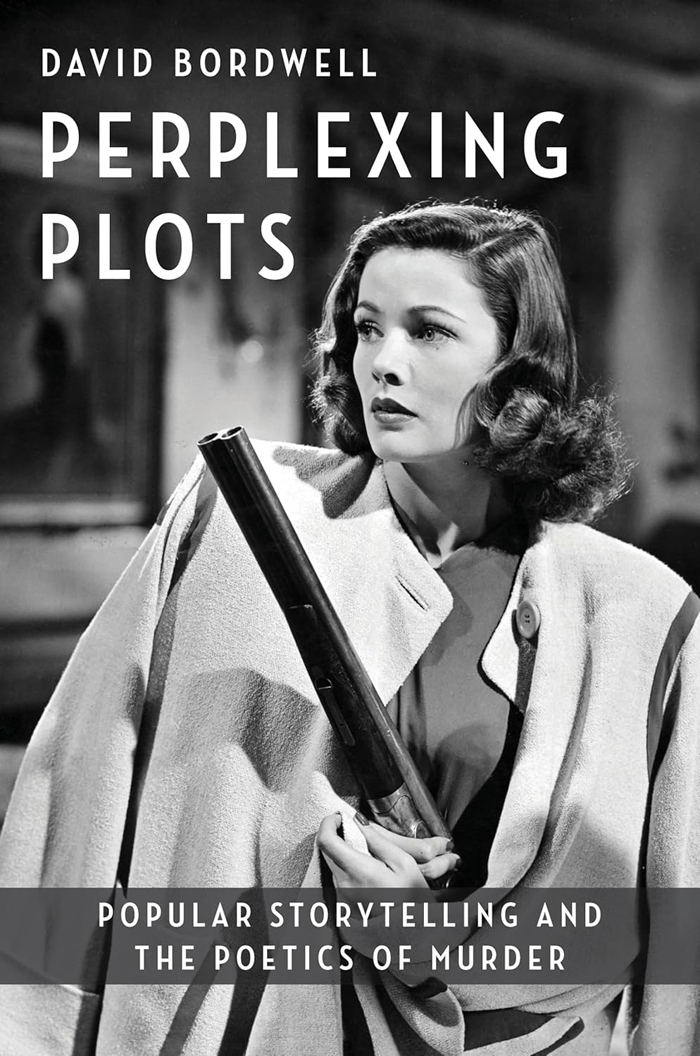
Back on February 10, less than three weeks before his death, David blogged about the positive reception that Perplexing Plots had had including a nomination for an Edgar Award from the Mystery Writers of America. He didn’t live to learn the result, but it didn’t win.
Now, however, comes news that the International Crime Fiction Association has given it one of the two top awards in its Sixth Annual ICFA Book Prize competition.
Thanks to Columbia University Press, especially Meredith Howard, for entering the book in the competition!
Posted in PERPLEXING PLOTS (the book) |  open printable version
| Comments Off on PERPLEXING PLOTS Prize open printable version
| Comments Off on PERPLEXING PLOTS Prize
Sunday | June 30, 2024
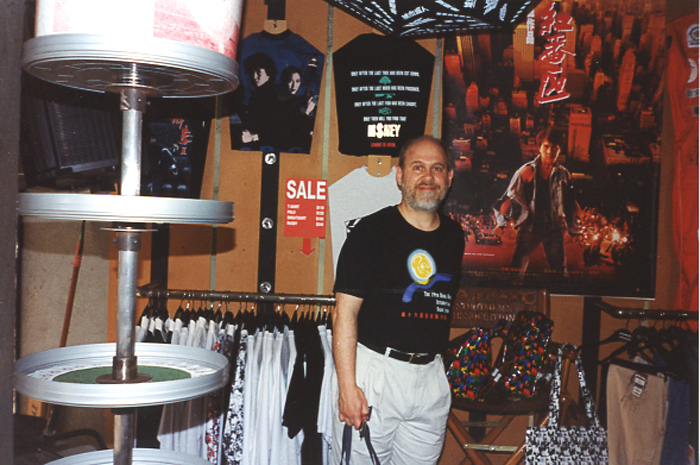
David shopping during his first trip to Hong Kong, 1995
Kristin here:
By now many of you have watched the recording of David’s May 18th memorial service, linked in the previous entry. Some have written to tell me how moving it was and how many aspects of David’s personal life and career the speakers covered. Absent, however, was one of the greatest loves of his professional life: his many visits to Hong Kong and his book on that city’s cinema were represented only by a video recording of his acceptance of an Asian Film Award in 2007. It was a lovely moment, but no one who could present personal recollections of David’s Hong Kong connection was among the speakers.
Now, however, Li Cheuk-to, David’s close friend throughout his days in Hong Kong and our visits to Il Cinema Ritrovato in Bologna, has written a piece that paints a vivid picture of David’s visits to Hong Kong. It conveys his deep enthusiasm for a national cinema that had largely been dismissed by critics and scholars in the West. The piece was posted online in Chinese on March 28, and Ah To, as we knew him, has kindly agreed to having the English version posted here.
Going back through the blog, I have found and linked entries written by David and describing some of the events that Ah To mentions below.
Planet Hong Kong
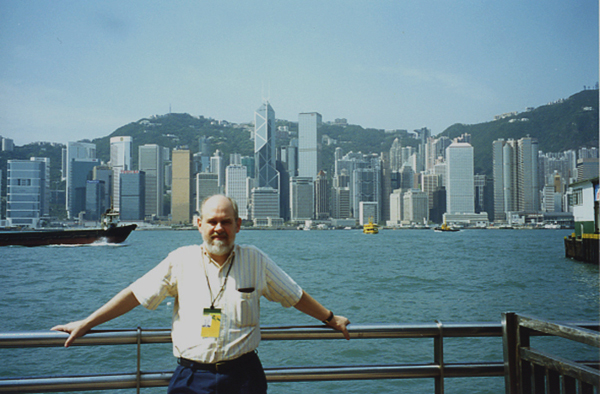
David in his element, 2000
David Bordwell passed away at the end of February, and the global mourning voices far exceeded the reaction to the death of any other film scholar. This proves that his wide circle of friends and profound influence go beyond the identity of a university professor. Apart from colleagues and students in academia, more responses came from friends he met at film festivals around the world, filmmakers, and fans who interacted with him through the blog “Observations on Film Art.” But what we feel most intimately connected to is his book Planet Hong Kong: Popular Cinema and the Art of Entertainment, in which he celebrated Hong Kong cinema as a self-sufficient industrial system outside Hollywood, possessing its own unique aesthetics. While he also introduced films from many countries around the world in Film History: An Introduction, the only national cinemas he wrote individual books on were American and Hong Kong cinema.
Bordwell’s works are generally more enjoyable than most academic writings. They are remarkably well-written, free of pedantry, and often sprinkled with witty humor. What’s rare is that he isn’t deliberately trying to be accessible; rather, he enthusiastically shares his insights with readers with an open mind, without any hint of the condescending attitude that many scholars inevitably adopt. In this respect, he is as easy-going as his writings; we all enjoy conversing with him because he never makes you feel inferior. He is also a willing listener who is open to different opinions, making it easy to achieve fruitful two-way communication. Expert on Chinese cinema Shelly Kraicer believes that he perfectly embodies the democratic spirit of American scholars and the tradition of trusting students’ intelligence, in contrast to the elitism of the European academia. I can’t agree more.
A fanboy’s first trip to Hong Kong
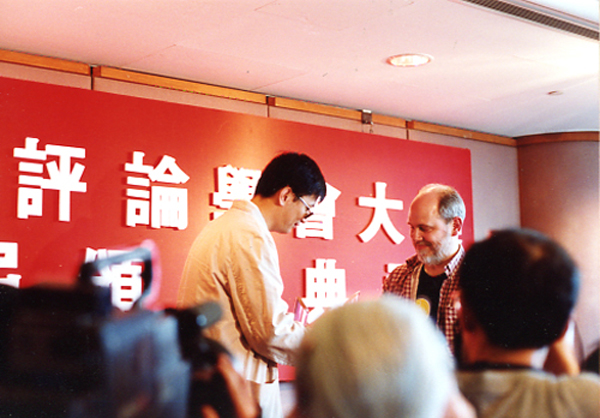
Planet Hong Kong as one of Bordwell’s most popular works stands out in these aspects, but it is by no means a coincidence. Because he openly admits that he has been an otaku (geek, nerd, or enthusiast) since childhood, discovering Hong Kong cinema through the kung fu films of the 1970s (Five Fingers of Death, Jeong Chang-hwa, 1972, and Fist of Fury, Lo Wei, 1972), just like many Western fans of Hong Kong movies. He even screened some of them in his classes. Unsatisfied with the usual channels like cinemas and film journals, he subscribed to fan magazines and collected videotapes and laserdiscs to update his knowledge of Hong Kong films. Therefore, he embodies a dual identity of a small fan and a distinguished professor, yet he neither falls into the fanaticism of a fanboy nor keeps a distance with the subject of study like most scholars. Instead, he maintains a clear-headed, heartfelt love for these films.
In 1995, his first visit to Hong Kong to attend the Hong Kong International Film Festival became a pivotal turning point. It was not only the centenary of cinema, but more importantly, the festival’s programme that year broadened his horizons. The new friends he made there made him feel at home, and he fell deeply in love with the city of Hong Kong: This will always be the place!
He wrote about the awe he felt sitting in the front row of the Hong Kong Cultural Centre’s Grand Theatre watching Abbas Kiarostami’s Under the Olive Trees. He also had the chance to see the newly unearthed Love and Duty with Ruan Lingyu (Bu Wancang, 1931), as well as new prints of The Orphan, starring the young Bruce Lee (Lee Sun-fung, 1960) and The Eight Hundred Heroes (Ying Yunwei, 1938). The festival that year opened with In the Heat of the Sun (Jiang Wen, 1994) and Summer Snow (Ann Hui, 1995). He could rewatch his beloved Chungking Express (Wong Kar Wai, 1994) and catch up on Hong Kong gems from the same year like He’s a Woman, She’s a Man (Peter Ho-Sun Chan, 1994), The Private Eye Blues (Eddie Fong, 1994), The Final Option (Gordon Chan, 1994), and The New Legend of Shaolin (Wong Jing and Corey Yuen, 1994). (Below, David and Peter Ho-Sun Chan.)
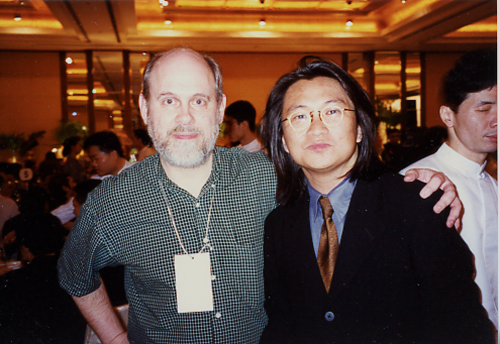
During that year, he also attended the presentation ceremonies of the Hong Kong Film Critics Society Awards and the Hong Kong Film Awards, where he met his admired stars and directors such as Wong Kar Wai, Ann Hui, and Tsui Hark, feeling ecstatic like a fanboy. (Above, David presents the Best Director award from the Hong Kong Film Critics Society for Ashes of Time.) However, more importantly, through the friends he made at the film festival and his experiences walking the streets and marveling at the architecture of Hong Kong, he truly felt the vibrant energy, fast pace, and visual stimulation of Hong Kong cinema, realizing its inseparable connection to the place and its people.
He admitted to becoming addicted to visiting Hong Kong from that point on, continuously attending the film festival in March and April for seventeen years without interruption (except in 2003 with the outbreak of SARS). In 1997, he wrote an article titled “Aesthetics in Action: Kung Fu, Gunplay, and Cinematic Expressivity” for the Hong Kong cinema retrospective catalogue Fifty Years of Electric Shadows. The following year, he wrote “Richness through Imperfection: King Hu and the Glimpse” for the retrospective catalogue Transcending the Times: King Hu and Eileen Chang. In retrospect, these two articles were early drafts of what would later become Planet Hong Kong. The former used Lethal Weapon and A Hearty Response (Norman Law Man, 1986) as examples to illustrate the stylistic differences in handling action scenes between Hong Kong films and Hollywood, which he also presented during a three-day symposium at the film festival, where the audience erupted into thunderous applause after the screening of the car chase scenes from the two films – what a memorable moment!
In fact, in the two to three years around the time of the handover in 1997, every time he visited Hong Kong, he met with many Hong Kong filmmakers in preparation for his book Planet Hong Kong. One unforgettable memory was a late-night gathering at the end of 1997 with members of the Hong Kong Film Critics Society, where they talked until the early morning and even went karaoke together! Keeto Lam and Bryan Chang still remember that he sang “All Kinds of Everything” and “Losing My Religion.” During that time, we agreed to have the translated version of the book edited by me on behalf of the HK Film Critics Society. After he completed the first draft the following year, he sent me a copy for review. The scene of staying late at the office and discussing the content with him over a two-hour long-distance call is still vivid in my memory today.
A fixture in Hong Kong film culture
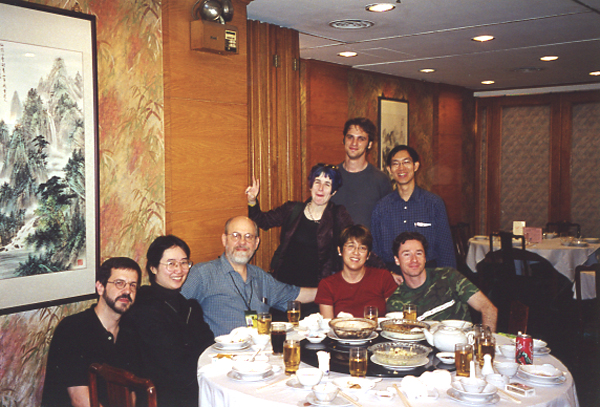
Seated, left to right, Shelley Kraicer, Athena Tsui, David, Erika Young, Nat Olson,
and standing, Ann Gavaghan, Tim Youngs, and Li Cheuk-to
Planet Hong Kong was published in 2000 (and in translation by Ho Wai-leng, Hong Kong: Hong Kong Film Critics Society, 2001) , and there was not enough time to write about Johnnie To in his Milkyway Image period in the book. However, when he was invited to be a visiting professor at the Hong Kong Academy for Performing Arts in 2001, he visited the set of Running Out of Time 2 (2001) and the two hit it off immediately. Since then, every time David visited Hong Kong, Director To extended his hospitality, and in the second edition of the book in 2010, David filled this gap and resolved any regrets. (Below, from the left, standing Lau Ching-wan, Yau Nai-Hoi, and Johnnie To; sitting, Ekin Cheng Yee-kin, David, and Kristin)
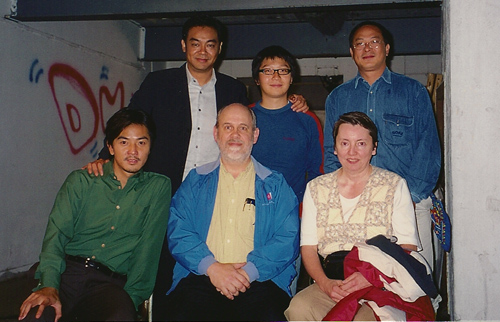
During this decade, the most special moment was in 2007 when he was awarded for “Excellence in Scholarship in Asian Cinema” at the inaugural Asian Film Awards, with Johnnie To as the presenter. Just like when he first visited Hong Kong, he took photos of and collected autographs from the surrounding stars and directors. Before the awards ceremony, in addition to discussing the content of the citation with Grady Hendrix, I also had Bryan Chang create a short complementary video featuring a stack of a dozen books that David had given me.
[Note: The online recording of David’s memorial service includes the presentation of the award, including Bryan Chang’s brief film. KT]
Two years later, he was invited to speak at a panel discussion on “The Controversial Centenary of Hong Kong Cinema” at the film festival, along with Law Kar, Frank Bren, and Wong Ain-ling, where they weighed the evidence for and against Stealing the Roast Duck (Leung Siu-po, 1909) and Zhuang Zi Tests His Wife (Lai Park-Hoi and Lai Man-Wai, 1914) as the first film made in Hong Kong.
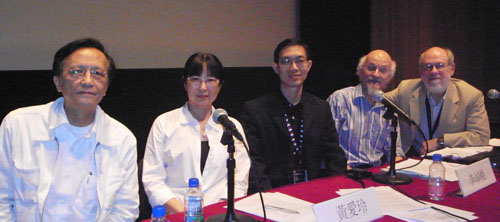
Law Kar, Wong Ain-ling, Li Cheuk-to, Frank Bren, and David
However, what excited him the most at that edition of the film festival was probably the “A Tribute to Romantic Visions” retrospective celebrating the 25th anniversary of Film Workshop (co-founded by Tsui Hark and Nansun Shi), featuring screenings, exhibition, publication, lectures, and parties, creating a star-studded and bustling atmosphere. Additionally, the successful restoration and resurfacing of Fei Mu’s lost work Confucius (1940) was also a great pleasant surprise for him.
A fanboy’s last trip to Hong Kong
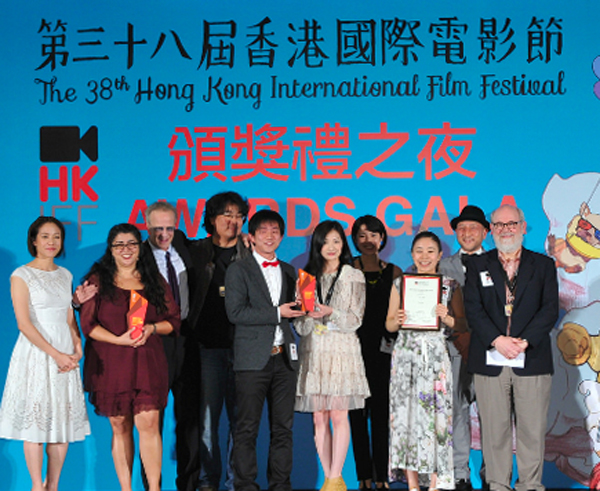
Unfortunately, around the same period, when he came to Hong Kong to attend the film festival, he experienced respiratory issues perhaps due to the air pollution in Hong Kong, often coughing uncontrollably. Athena Tsui remembers accompanying him to a private hospital for a late-night visit (to avoid disrupting the next day’s work), where they even summoned a radiographer in the middle of the night to take X-rays for him, and he quickly received the results, indicating no immediate danger. After returning to his home country, he showed the report to his own doctor, who greatly praised the professionalism, efficiency, and expertise of the Hong Kong medical staff, once again leaving him in awe.
Due to this chronic lung condition, he heeded the doctor’s advice not to come to Hong Kong for two years. In 2014, he accepted an invitation to join the jury for Young Cinema Competition at the film festival (other jury members included Bong Joon-ho, Karena Lam, and Christopher Lambert, above), marking his final visit to Hong Kong. Nevertheless, being able to see the director’s black-and-white version of Mother and engage in deep discussions with Bong Joon-ho could be considered as leaving a good memory, right? In the following years, the only occasion where he would meet with me annually was at the Il Cinema Ritrovato Festival in Bologna, Italy at the end of June, where he always appeared alongside his wife, Kristin Thompson.
Kristin is also a renowned film scholar who co-authored two classic film textbooks with David, and their blog was co-written, as we all know. However, she is also an Egyptologist who conducts research in Egypt once a year, like David’s annual visits to Hong Kong. Over the years, she accompanied her husband to the film festival in Hong Kong once in 2000. Athena Tsui remembers their fondness for desserts from The Sweet Dynasty, such as walnut and almond soup.

David particularly enjoyed mango pudding and was a regular customer at Hui Lau Shan. Before the closure of KPS Video Express, he would always buy many Hong Kong movie laserdiscs whenever he visited Hong Kong.
[Note: Many of these laserdiscs are now in David’s and my collection in the Wisconsin Center for Film and Theater Research. KT]
In recent years, due to the COVID-19 pandemic, we naturally missed the chance to meet again. Last September, I had planned to visit him in Wisconsin, Madison after attending the Toronto International Film Festival. Unfortunately, his health deteriorated, requiring hospitalization, and we missed seeing each other once again. Occasionally, we would receive emails from Kristin updating us on his condition. Eventually, we received the sad news of his passing. It was reassuring to know that in his final days, they would watch a movie together every night, and on the last night, they rewatched two episodes of The West Wing. For those who truly care, this was a comforting end.
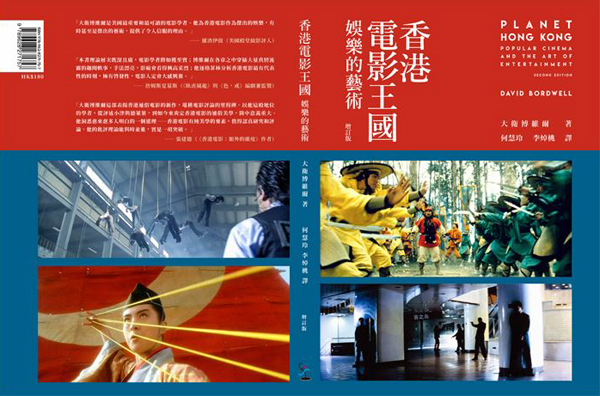
Lastly, it must be noted that six years ago when we decided to publish the translated version of the second edition of Planet Hong Kong (with the new material translated by Li Cheuk-to, aided by a few friends), he promptly wrote a new postscript for it without hesitation, for which we are truly grateful. Looking back today, when we sent him the printed translated version four years ago, he was still well amid the pandemic. Undoubtedly he was delighted to see that he finally completed a full circle with his connection to Hong Kong cinema. At the time, this Chinese version was meant to commemorate Wai-leng. Today, as David has passed away, I realize that this can also be seen as showing our utmost gratitude and respect to him.
The second edition of Planet Hong Kong is available for free here. There is still a notice about not copying the book for others, but that is left over from the days when David was selling his digital books online. The page where the book is available also has David’s description of how he came to love Hong Kong cinema, visited Hong Kong for the festival, and wrote the book.
The blog entries on Hong Kong that I have linked here are only a few of the many he posted. The rest can be found by clicking on the “National Cinemas: Hong Kong” link in the menu at the right.
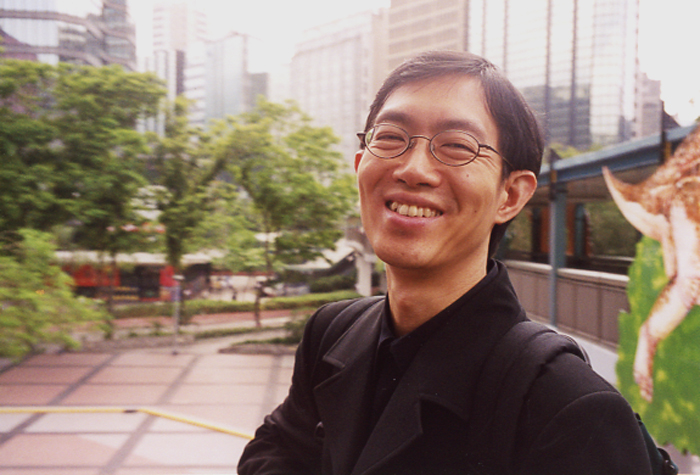
Li Cheuk-to, photographed by David in 2000
Posted in National cinemas: Hong Kong, PLANET HONG KONG: backstories and sidestories |  open printable version
| Comments Off on David Bordwell’s Hong Kong Connection: A Guest Post by Li Cheuk-to open printable version
| Comments Off on David Bordwell’s Hong Kong Connection: A Guest Post by Li Cheuk-to
Sunday | June 9, 2024

KT here:
A memorial service for David was held on May 18, 2024. Although many friends and family members traveled to be present, the service was also streamed live for those who could not.
For those who were unable to do either, a recording of the service has been posted on Vimeo. The link is below.
There was a delay of a few weeks in posting it.
The wait was worth it. Thanks to Erik Gunneson, who also handled the technical aspects of the service itself, the recording is much improved. Erik is a faculty associate in the Department of Communication Arts here at the University of Wisconsin-Madison. He added superimposed titles to identify the speakers and the musical pieces. (The musical pieces were all chosen by David.) He also replaced the music as recorded in the room on the day with music from the original CDs, much improving the quality. Finally he added a lovely quotation from an exchange of email messages I had with our friend Damien Chazelle on the day after David died. Essentially all the information in the program is now in the recording.
When you click on the link, you will be taken to Vimeo. You may be asked to sign in or sign up with Vimeo. This should not be necessary. Just click on the X and the window should close. There is no need to sign up, and there is no password. It helps if you make the image full-screen.
The recording was done by a service used by the funeral service. It started about 17 minutes before the actual service began with the first musical piece. During that 17 minutes, we simply see people arriving and talking and finding their seats. Some of you may want to watch this and spot old friends. At one point one of the funeral staff is visible carrying in a chair. There were not enough chairs for the number of guests, though after more were set out, everyone was able to get a seat in the room. If you don’t want to watch this part, use the slider to go forward to about 17:40. (The music up to that point was supplied by the recording company.)
The entire recording lasts about two hours and twenty minutes.
Thanks to all involved. The service went even better than I had hoped, thanks to our wonderful host and speakers. As you will see, it was a very fitting celebration of David’s life, with much of his humor mixed with the beautiful tributes.
Posted in Film comments |  open printable version
| Comments Off on A recording of David’s memorial service is now online open printable version
| Comments Off on A recording of David’s memorial service is now online
Sunday | May 26, 2024

The Shepherdess and the Seven Songs (2020).
Since David’s death, this blog has not been updated. I do, however, plan to occasionally re-post old entries if they become relevant to current events in the world of film. I also hope to post new entries as the inspiration strikes me.
This entry deals with Mohammad Rasoulof’s There is No Evil (2020), including information on his troubles with the government at the time. Since he has now gone into exile and had a new film, The Seed of the Sacred Fig, showing at Cannes, I hope this entry serves as a reminder of his earlier films. (Links below lead to other posts on his films, including The White Meadow and Manuscripts Don’t Burn.)
Kristin here:
Among the always bounteous offerings of the Vancouver International Film Festival, my favorite section is “Panorama,” since I enjoy seeing new films from countries all around the globe. Often some of these are from Iran, and the two Iranian films featured this year did not disappoint. The sole Indian film turned out to be an engaging, imaginative tale from an area of the world seldom represented on the screen.
There Is No Evil (2020)
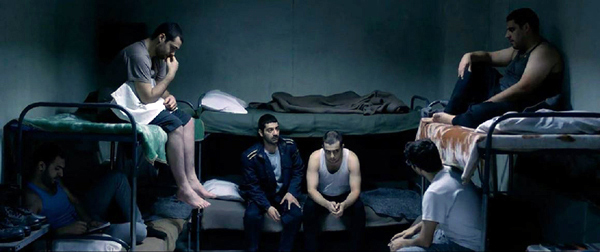
Vancouver is in part a festival of festivals, drawing upon international films already premiered in Berlin, Cannes, Rotterdam, and other earlier festivals. Of necessity, this year’s items come from the pre-Coronavirus festivals, with films from Berlin especially prominent in the schedule. Mohammad Rasoulof’s There Is No Evil, Golden Bear winner as best film, continued the director’s regular contributions to past Vancouver festivals. (For entries on other Rasoulof films we have seen at Vancouver, see here and here.) Christian Petzold’s Undine, discussed by David in the previous entry, won the Silver Bear as best actress for Paula Beer.
There Is No Evil is a deeply ironic title, since its four self-contained episodes deal with one of Iran’s notorious evils, its record for executing its citizens. As Peter DeBruge pointed out in his Variety review, “According to Amnesty Int’l statistics, Iran was responsible for more than half the world’s recorded executions in 2017. The number has since dropped, but the country continues to kill its citizens at alarming rates.”
Often the process of carrying through executions is assigned to hired civilians or is forced to be performed by soldiers. Rasoulof explores various ways in which such executions affect the willing or unwilling people who carry out the orders, as well as the effects on people they know and love. I don’t want to spoil the slow development of these consequences for the characters by describing the plots of each of the four episodes in too much detail. Suffice it to say that the revelation of those consequences are worked up to very slowly and occur dramatically.
The four episodes are shot in quite different styles. Those styles are to a considerable extent determined by the fact that the episodes move to increasingly remote locales.
The first begins in a bustling city and is shot in a bright, ordinary style befitting the depiction of a bourgeois lifestyle, with appointments to pick up spouses and children, shopping trips, and alternately bickering and affectionate conversation.
The second episode abruptly switches to a gloomy, desaturated color scheme of grays and muted browns and greens suited to a film noir (above). This segment begins with a military man assigned to perform an execution panicking because he cannot face killing anyone. During this episode, the tone and even the genre switch abruptly twice, from film noir to thriller to … something else.
The third story has a soldier on leave visiting a family of old friends, including the daughter whom he loves and hopes to become engaged to. Here the film is done in a lyrical, bright style, emphasizing scenes in the lush woods and in the happy rural home of a couple who foster a group opposing the government. Here the soldier talks with the mother of the family.

The fourth episode centers on a couple who have retired to a bee-keeping farm in a remote, mountainous area. They must contend with the visit of a niece, but neither is willing to answer her questions about the past.
I think the style in this part pays homage to Abbas Kiarostami, with numerous shots of the couple’s pickup on winding country roads (see bottom). There’s a specific echo of The Wind Will Carry Us in the motif of the girl’s repeated attempts to find cell-phone coverage to call her parents abroad.
Given the relatively large cast and considerable number of interior and exterior locales, one might wonder how Rasoulof, under an order to stop filmmaking, could make a two-and-a-half hour film critical of government policy. DeBruge’s review, linked above, also comments: “By subdividing the project like this, Rasoulof was able to direct the segments without being shut down by authorities — who are more carefully focused on features — and, in the process, he also builds a stronger argument.” In an earlier Vancouver report, we noted that Rakhshan Bani-Etemad’s Tales (2014) used a network-narrative structure because she could only get permission to make a series of shorts–which she then wove together into a feature.
As DeBruge writes, the reliance on episodic structure does not handicap Rasoulof. The slow accumulation of indifference, regret, and guilt demonstrates that executions have unnoticed, unforeseen, and undeserved effects. The stylistic shifts emphasize the differences in those effects and maintain interest across a long film.
The effectiveness of Rasoulof’s film has not gone unnoticed, however, and a Golden Bear is clearly not enough to protect him. On March 4, he was summoned to begin serving his long-delayed prison term, despite the widespread incidence of COVID-19 in Iranian prisons. (On March 1, three days before the summons, Indiewire published a history of government strictures on Rasoulof.) Many official protests have been launched, and one can only hope that once again the result will be yet another suspension of the enforcement of the sentences against him.
Yalda, a Night for Forgiveness (2019)

Yalda is the second feature by Iranian director Massoud Bakhshi, whose first, A Respectable Family, we recommended as “an unexpected gem” when it played in Vancouver in 2012. Yalda is another film that comes to Vancouver via this year’s Berlin International Film Festival, where it was nominated for a Crystal Bear. It also played at the Sundance Film Festival, where it won the Grand Jury prize in the “World Cinema – Dramatic” category.
The film centers around one episode of a television series, “Joy of Forgiveness,” based on the premise that each week someone convicted of a crime seeks to be forgiven by the victim or a relative of the victim. Although not an actual law, such forgiveness is encouraged in Iran under Islamic law. If forgiveness can be obtained, the criminal is typically absolved of the crime. There are now charities, celebrities (including film director Asghar Farhadi), and other forces working informally to foster forgiveness and free guilty people, though this may include a payment of “blood money” given to the person doing the forgiving. (A real TV show based on this premise, “Honey Moon,” was the inspiration for Yalda.)
In this case, a young, shy working-class woman, Maryam, who had been married to a wealthy older man, has been convicted of killing her husband. She insists, however, that it was an accident. As the film begins, Maryam’s mother brings her to the television station. The young woman is terrified and declares she does not want to participate. But since this would mean a death sentence being carried out, her mother and the production team of the show ignore her protestations and hurry her through the preparations.
Representing the victim is Mona, his daughter, who, as the title of the TV series suggests, is expected to provide the standard happy ending to the show by forgiving Maryam. Mona seems to have reasons to do so, since she would receive the blood money proffered by “Joy of Forgiving” and is planning to emigrate from Iran in the near future.
So far we seem to have a situation familiar from the films of Asghar Farhadi, with two or more people at odds who are gradually revealed to be flawed and to some degree at fault. The situation then typically ends in reluctant understanding between or among the opponents.
As the host interviews the two women, however, he shows a distinct bias toward Mona’s viewpoint. Rather than pleading her case humbly, as the television crew expects, Maryam becomes desperate and accusatory. Her exchanges with Mona grow more heated.
The producers begin to panic. As one points out, this show is occurring on Yalda, a festival held on the day of the winter solstice. The longest night of the year is believed to be unlucky, and traditionally Iranian families gather to eat, tell stories, read poetry, and generally cheer each other up through the night. Seeing a sad ending to the program would badly disappoint the audience.
Telling his story in what is essentially continuous time and at a brisk pace, Bakhshi starts out by sticking closely to Maryam, building up considerable sympathy for her as everyone ignores her pleas and bosses her around. Once the program begins, the increasing hostility of Mona generates a suspense that is well maintained up to the final twists of the ending–twists showing that Bakhshi is not going for a Farhadi-style resolution.
The script is tightly constructed and engrossing, so much so that one could imagine a Hollywood remake–if a plausible legal situation could be devised as the premise.
The Shepherdess and the Seven Songs (2020)
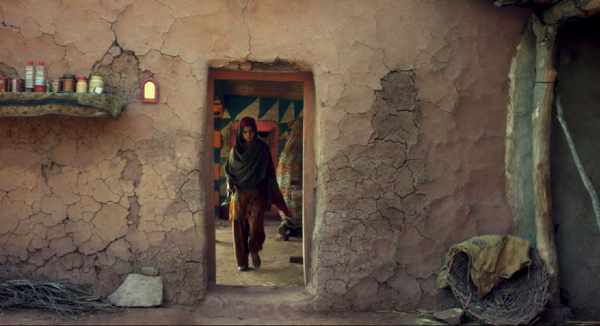
The Shepherdess and the Seven Songs (director Pushpendra Singh) also was shown at the Berlin festival, in its Encounters section. It also won best director in the “Young Cinema Competition (World)” at the online competition for this year’s cancelled Hong Kong International Film Festival.
The film begins with a young man, Tanvir, struggling to lift and shoulder a heavy stone, a traditional test for a prospective husband among a tribe to which whom the beautiful shepherdess of the title, Laila, belongs. Soon a title is superimposed: “Song of Marriage,” the first of the seven songs. These songs are sung over the action–unsubtitled, unfortunately–and give a sense of the story taking place in some old folk tale. (Indeed, a title in the credits declares that the film is “Based on a Rajasthani folk-tale by Vijaydan Detha,” a well-known twentieth-century author of numerous such short stories.)
The fact that the tribes cook over open fires and follow what seem to be old traditions reinforces this impression, until a night scene where some of the men wield LED flashlights. Another title, “Song of Migration,” leads to a the journey of the nomadic tribe into which Laila has married herding their large flock toward the village that is their home base. They pass along modern highways, moving aside for traffic to pass, through landscapes that provide beautiful shots (see the top of this entry). This stretch of the film is lyrical and captivating, thoroughly drawing the spectator into the film.
Abruptly another modern touch, a radio carried by one of the men, thrusts the action into the troubled politics of the present. A newscaster declares, “In the Kashmir Valley protests against Article 5A have escalated.” Two protestors, he says, have been killed. The reference is to Pakistan and India’s dispute over control of Kashmir, and the Kashmiri struggle for independence from both. Laila, it later is revealed, is Kashmiri, while Tanvir’s tribe lives in an area controlled by India.
Laila’s beauty soon attracts the attention of the local Station-master and his subordinate, Mushtaq. They hint that as a Kashmiri she might possibly be a terrorist. This accusation comes to nothing, and Mushtaq’s clumsy attempts to seduce Laila lead to a switch in tone. A series of episodes, each a separate “song,” follow Laila promising trysts with him and then bringing her husband along on a pretext. Mushtaq’s continued gullibility in trusting that each new assignation is made in earnest lends a farcical comic touch to this lengthy passage of the film. At the same time, however, Laila is testing whether her husband, strong enough to lift the stone and win her as his bride, has the moral power to defend her rather than currying favor with Mushtaq by turning a blind eye to his designs on Laila.
I felt that the last portion of the film ran out of the energy it had sustained so well, since Laila is strong enough to turn her back on two unacceptable men but has no apparent sense of where to turn once she has done so. Still, overall The Shepherdess is beautifully filmed, as the frames at the top of this section and of the entry demonstrate. It also tells a thoroughly absorbing story.
So far David and I have reported on six films from this year’s Vancouver festival. Already it has become clear that our accumulated experiences from past years have allowed us to trace the development of promising young filmmakers into great ones and to discover promising new ones whom we hope to encounter at future festivals.
Thanks to Alan Franey, PoChu AuYeung, Jane Harrison, and their colleagues for their help during the festival.

There Is No Evil (2020).
Posted in Film comments, National cinemas: India, National cinemas: Iran |  open printable version
| Comments Off on Repost of Vancouver: Three gems from Iran and India open printable version
| Comments Off on Repost of Vancouver: Three gems from Iran and India
|

































